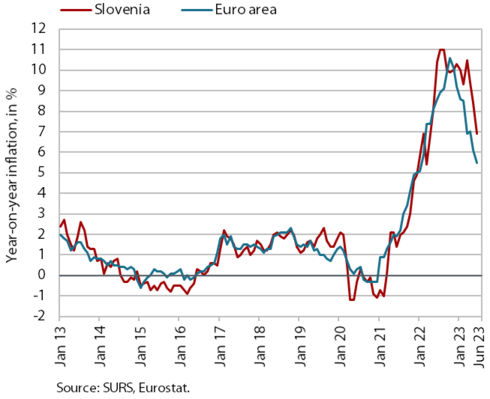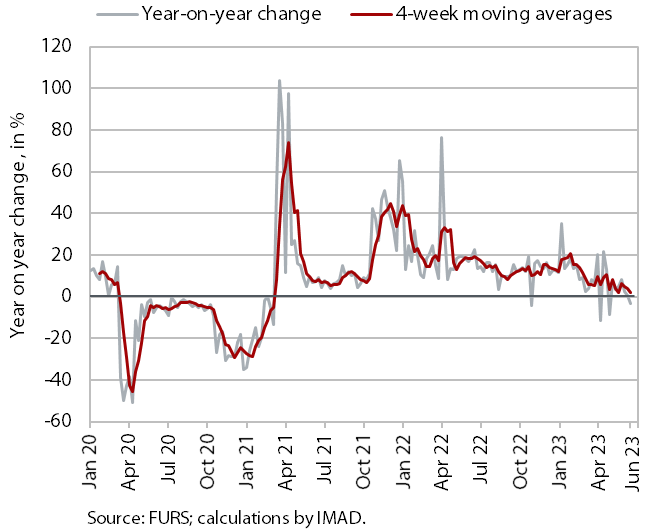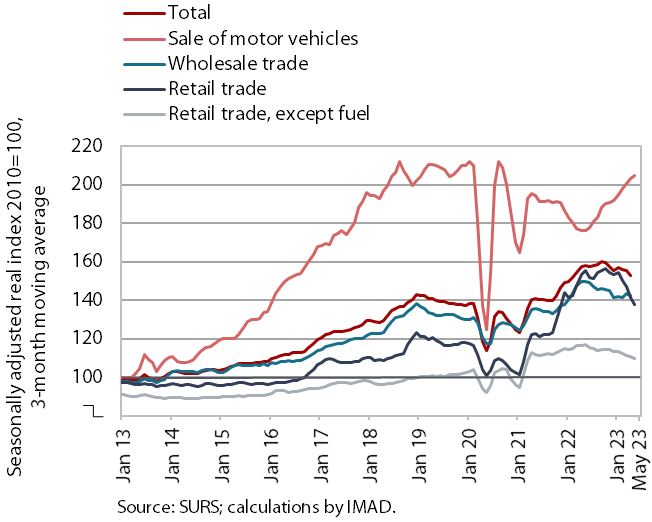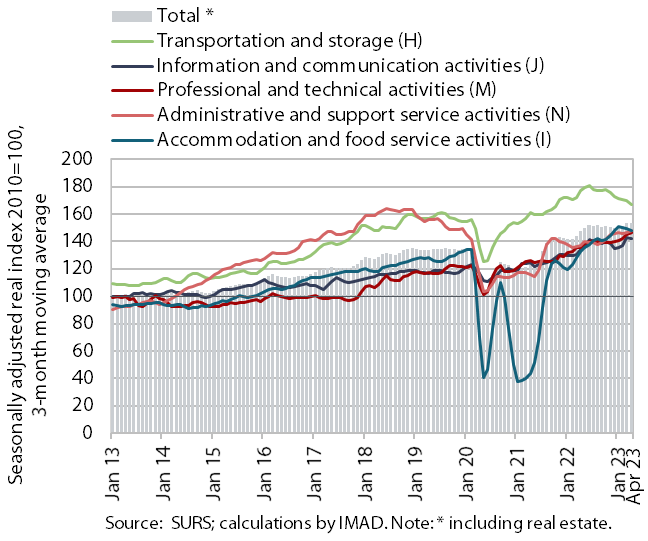Charts of the Week
Charts of the week from 26 to 30 June 2023: consumer prices, value of fiscally verified invoices, turnover in trade and turnover in market services
Year-on-year growth in consumer prices slowed significantly in June, as expected, to 6.9%, the lowest level since April last year. The decline in inflation was mainly due to a much lower growth in the prices of housing, water, electricity, gas and other fuels, on a higher base due to the expiry last year of the measure introducing an exemption from the payment of certain levies and charges on electricity, although the VAT returned to its previous higher rate. The year-on-year growth in food prices was still relatively high in June (12.1%), but has gradually moderated. Growth in the prices of goods and services in the health sector has accelerated sharply and was the highest among all 12 CPI groups of goods and services. After rising in the first quarter, real turnover fell in most market services in April. It was also lower year-on-year, reflecting lower turnover in transportation and storage and information and communication. Turnover in most trade sectors was also lower year-on-year in April, with the exception of the sale of motor vehicles, where, according to preliminary data, turnover was significantly higher year-on-year also in May. The nominal value of fiscally verified invoices shows that similar trends in trade continued in June.
Consumer prices, June 2023

Year-on-year growth in consumer prices slowed significantly in June, as expected, despite the higher VAT rate on certain energy products. At 6.9%, it was 1.5 p.p. lower than in May and the lowest since April last year. The year-on-year decline in inflation was mainly due to a much lower increase in the prices of housing, water, electricity, gas and other fuels, on a higher base due to the expiry last year of the measure introducing an exemption from the payment of certain levies and charges on electricity, although the VAT returned to its previous higher rate. Year-on-year growth in food prices was still relatively high at 12.1%, but has gradually moderated (14.7% in May). Year-on-year growth in the prices of goods and services in the health sector has accelerated sharply in recent months and at 13.3% was the highest among all 12 CPI groups of goods and services. Broad-based year-on-year growth in service prices remains slightly below 8.5%. It is driven by higher prices in the groups recreation and culture, restaurants and hotels, and other services. Amid a slowdown in household spending, minor supply chain disruptions and stable commodity market conditions, the growth in durable goods prices has moderated, to 3.5% year-on-year in June. The growth of semi-durable goods prices remained broadly unchanged (5.7%).
Value of fiscally verified invoices, in nominal terms, 11–24 June 2023

The nominal value of fiscally verified invoices between 11 and 24 June was lower year-on-year for the first time this year (by 2%). The lower year-on-year turnover was mainly due to lower turnover in trade (by 3%), which accounted for 77% of the total value of fiscally verified invoices. Turnover in wholesale and retail trade was lower year-on-year (by 6% and 5% respectively), while turnover in the sale of motor vehicles was up 14%. For the first time this year, turnover in accommodation and food service activities was lower year-on-year (by 3%), mainly due to high turnover last year before the expiry of the deadline for the redemption of tourism vouchers.
Turnover in trade, April–May 2023

In April, turnover in the sale of motor vehicles was higher year-on-year, while it was lower in wholesale and retail trade. Turnover in the sale of motor vehicles, which has been rising in current terms since the second half of last year, was up by 15.2% year-on-year in April. After declining in current terms in the previous three months, the year-on-year decline of turnover in wholesale trade (8.3%) intensified in April. The year-on-year decline in retail trade remained relatively high in April, although turnover remained at previous month’s level. Turnover in retail sale of food, beverages and tobacco fell by 6.9% year-on-year, while in the sale of non-food products it fell by 6.4%. According to preliminary SURS data, turnover in May was still lower year-on-year in retail trade and higher in the sale of motor vehicles.
Turnover in market services, April 2023

Real turnover in market services fell significantly in April. After rising in the first quarter, it fell by 4% month-on-month. In addition to transportation and storage, where turnover has been declining since May last year, turnover was down in most other market services in April, especially in information and communication activities, with both main sectors (telecommunications and computer services) contributing to the decline. The decline was somewhat smaller in professional and technical activities, where turnover fell in all segments. The decline was smallest in administrative and support service activities, while turnover increased again in employment services. Turnover in accommodation and food service activities was similar to the previous month. Year-on-year, total turnover fell by 2.2% in real terms in April due to a decline in turnover in transportation and storage and information and communication activities. It remained below pre-epidemic (April 2019) levels in administrative and support service activities (by -9%) and, after a prolonged period in transportation and storage (by -4%).
